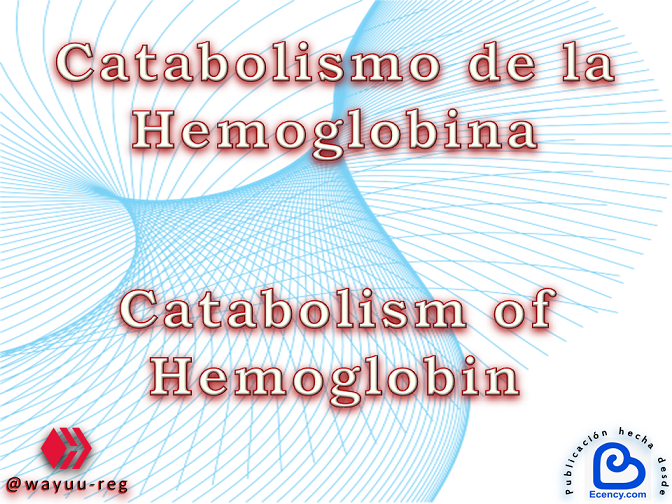
Una vez que la hemoglobina ha sido convertida en sus componentes, el Hemo es oxidado por una enzima microsómica, la Oxigenasa del hemo, para producir un compuesto tetrapirrólico de cadena abierta conocido como Biliverdina, el cual es rápidamente reducido a Bilirrubina, por intermedio de una enzima citoplásmica que requiere NADPH y que se llama Reductasa de Bilirrubina.
Once hemoglobin has been converted into its components, hem is oxidized by a microsomal enzyme, hem oxygenase, to produce an open-chain tetrapyrrole compound known as Biliverdin, which is rapidly reduced to Bilirubin, via a cytoplasmic enzyme that requires NADPH and is called Bilirubin Reductase.
⊛ Catabolism of Hemoglobin ⊛
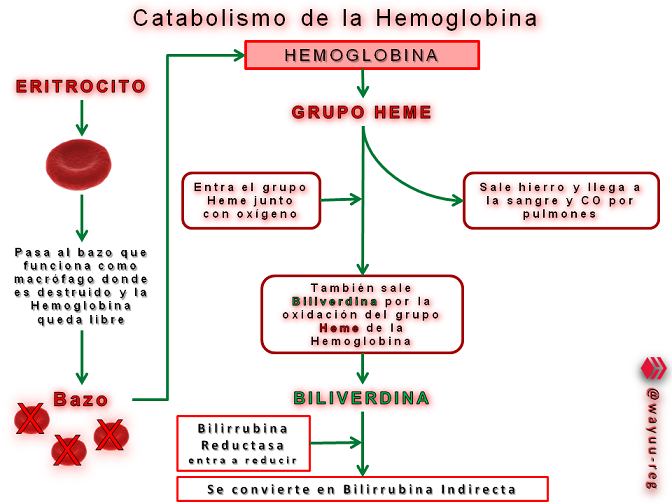
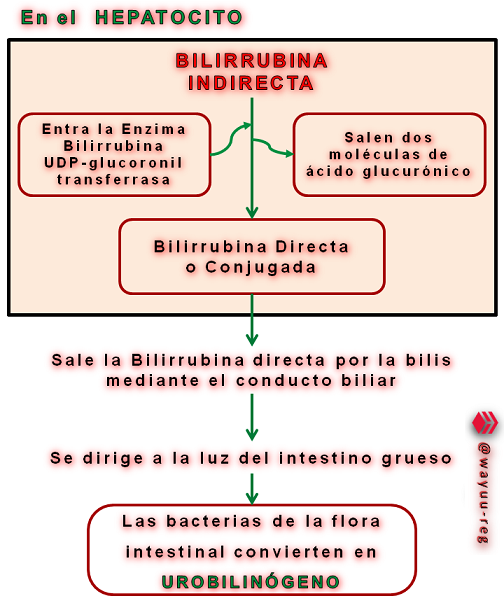
En el proceso de conversión del hemo en bilirrubina, se genera monóxido de carbono debido a la remoción oxidativa del Puente alfa-meteno. Este monóxido de carbono es transportado como carboxihemoglobina a los pulmones y es expulsado. Un estudio (1950) determinó que la producción de bilirrubina aparece marcada en los dos primeros días y por lo tanto no podía provenir de eritrocitos viejos, sino que esta fracción precoz provenía de normoblastos destruidos en el curso de la eritropoyesis, lo que se llama Eritropoyesis Infestiva, y del catabolismo de precursores del hemo.
In the process of conversion of hem to bilirubin, carbon monoxide is generated due to the oxidative removal of the alpha-methylene bridge. This carbon monoxide is transported as carboxyhemoglobin to the lungs and is excreted. One study (1950) determined that bilirubin production appears marked in the first two days and therefore could not come from old erythrocytes, but that this early fraction came from normoblasts destroyed in the course of erythropoiesis, which is called Infestive Erythropoiesis, and from catabolism of hem precursors.
Esto trajo el concepto de hiperbilirrubina por cortocircuito (Shunt), que se observa en ciertas anemias diseritropoyéticas, como el caso de las talasemias y anemias megaloblásticas.
This brought the concept of short-circuit hyperbilirubin (Shunt), which is observed in certain dyserythropoietic anemias, such as thalassemias and megaloblastic anemias.
La bilirrubina aparece en el plasma una vez que es liberada del sitio de catabolismo del hemo, conociéndose como bilirrubina libre o indirecta.
Bilirubin appears in plasma once it is released from the site of hem catabolism, being known as free or indirect bilirubin.
El valor normal de la bilirrubinemia es de 0,5 a 1,0 mg/dl. La bilirrubina viaja unida a la albumina, pudiendo cada molécula de albumina combinarse con 2 moléculas de bilirrubina. El hemo, los ácidos grasos, sulfas y salicilatos compiten con la bilirrubina por sus silos de unión con la albumina; por lo tanto en su presencia la bilirrubina difunde a los tejidos, especialmente a aquellos ricos en lípidos.
The normal value of bilirubinemia is 0.5 to 1.0 mg/dL. Bilirubin travels bound to albumin, and each molecule of albumin can combine with 2 molecules of bilirubin. Hem, fatty acids, sulfas and salicylates compete with bilirubin for their binding silos with albumin; therefore in their presence bilirubin diffuses to tissues, especially those rich in lipids.
Una pequeña cantidad de bilirrubina conjugada con ácido glucorónico (bilirrubina directa) se encuentra en el plasma; esta forma de bilirrubina es soluble y filtra a través del glomérulo, produciendo bilirrubinuria o coluria.
A small amount of bilirubin conjugated with glucuronic acid (direct bilirubin) is found in the plasma; this form of bilirubin is soluble and filters through the glomerulus, producing bilirubinuria or choluria.
No se conoce completamente la manera como el hepatocito capta la bilirrubina. En el hepatocito existen dos proteínas capaces de unirse con la bilirrubina. La Proteína Y o Ligandina (es una proteína perteneciente al grupo que tiene actividad de glutatión-transferasa, es transportada al retículo endoplasmático y se conjuga con el ácido glucurónico) es un dímero de peso molecular 44.000, y la Proteína Z, de peso molecular 9 ó 10.000. Ciertas drogas, como el Fenobarbital, aumentan mucho la cantidad de proteína Y sin afectar la cantidad de proteína Z.
The way bilirubin is taken up by the hepatocyte is not completely understood. In the hepatocyte there are two proteins capable of binding bilirubin. Protein Y or Ligandin (a protein belonging to the group that has glutathione transferase activity, is transported to the endoplasmic reticulum and conjugates with glucuronic acid) is a dimer of molecular weight 44,000 , and Protein Z, of molecular weight 9 or 10,000 . Certain drugs, such as Phenobarbital, greatly increase the amount of Protein Y without affecting the amount of Protein Z.
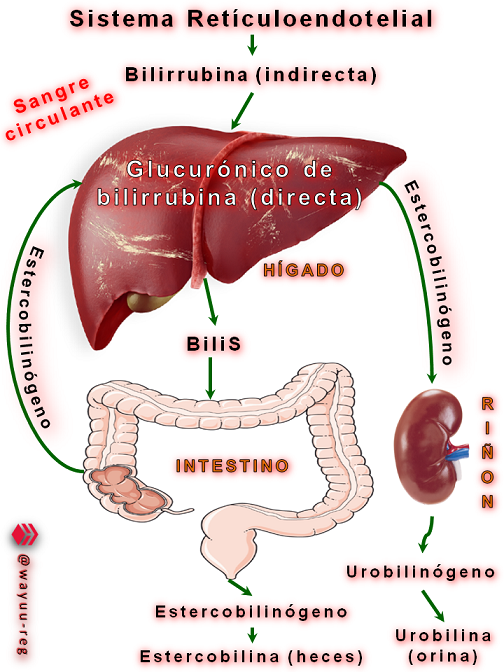
Una vez que, por intermedio de estas proteínas, la bilirrubina entra al hepatocito, se conjuga con dos moléculas de ácido glucurónico por intermedio de una enzima llamada Glucuroniltransferasa. Una pequeña cantidad de bilirrubina se conjuga con sulfato en vez de hacerlo con ácido glucurónico. Una vez conjugada la bilirrubina es excretada, por el polo biliar del hepatocito, a la bilis, mediante un proceso activo. En el intestino, la bilirrubina es hidrolizada y reducida a un grupo de sustancias conocidas genéricamente como Urobilinógeno, incoloro, que es posteriormente dehidrogenado a urobilinas que dan el color característico a las heces.
Once, through these proteins, bilirubin enters the hepatocyte, it is conjugated with two molecules of glucuronic acid by an enzyme called Glucuronyl-transferase. A small amount of bilirubin is conjugated to sulfate instead of glucuronic acid. Once conjugated, bilirubin is excreted by the biliary pole of the hepatocyte into the bile by an active process. In the intestine, bilirubin is hydrolyzed and reduced to a group of substances known generically as Urobilinogen, colorless, which is subsequently dehydrogenated to urobilins that give the characteristic color to the feces.
Del 10 al 20% del urobilinógeno es reabsorbido por el intestino y re-excretado por el hígado (circulación enterohepática), pero una pequeña cantidad se filtra por el glomérulo y aparece en la orina.
From 10 to 20% of urobilinogen is reabsorbed by the intestine and re-excreted by the liver (enterohepatic circulation), but a small amount is filtered by the glomerulus and appears in the urine.
¡ Muchísimas gracias
por su amable atención !
por su amable atención !
Y recuerde que donar sangre, es salvar muchas vidas…
Thank you very much
for your kind attention !
for your kind attention !
And remember that to donate blood, is to save many lives...

Fuentes Bibliográficas (Bibliographic Sources)
- Eritropoyesis
- Fisiología de la Eritropoyesis
- Eritropoyesis
Todas las imágenes de esta publicación son de dominio público (CC0), fueron editadas con la aplicación Paint y PowerPoint como imagen PNG
La imagen GIF, con fotografías personales, fue editada con la aplicación en línea Picasion.com
Se utilizó el Logo de Hive.blog (CC0) y Ecency Logo
La traducción fue realizada por DeepL
All images in this publication are in the public domain (CC0) and were edited with Paint and PowerPoint as PNG images
The GIF image, with personal photos, was edited with the online application Picasion.com
The Hive.blog Logo (CC0) and Ecency Logo was used
The translation was made by DeepL
Me sentiría muy complacida en recibir su valioso comentario y constructivas sugerencias acerca del tema presentado, ya que serán considerables para el mejoramiento de las futuras publicaciones
¡ G R A C I A S !
I would be very pleased to receive your valuable comments and constructive suggestions on the topic presented, as they will be considerable for the improvement of future publications
T H A N K Y O U !
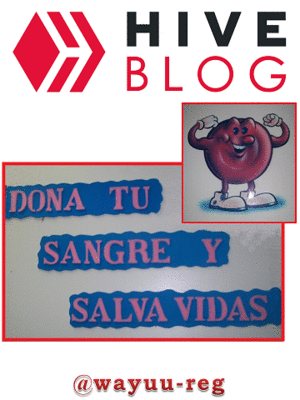
Otro buen trabajo poco reconocido. Pero sigue adelante @wayuu-reg
Lo más importante es que permites que otras personas puedan leerte por la web y contribuir con el conocimiento científico que dejas plasmado en tus artículos.
Dios te cuide siempre!
Congratulations @wayuu-reg! You have completed the following achievement on the Hive blockchain and have been rewarded with new badge(s):
Your next target is to reach 500 replies.
You can view your badges on your board and compare yourself to others in the Ranking
If you no longer want to receive notifications, reply to this comment with the word
STOPSupport the HiveBuzz project. Vote for our proposal!